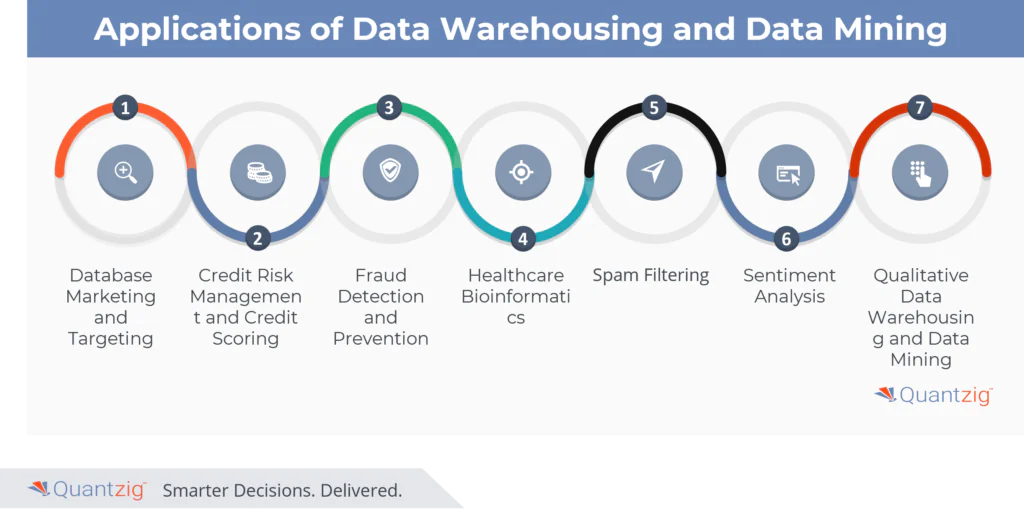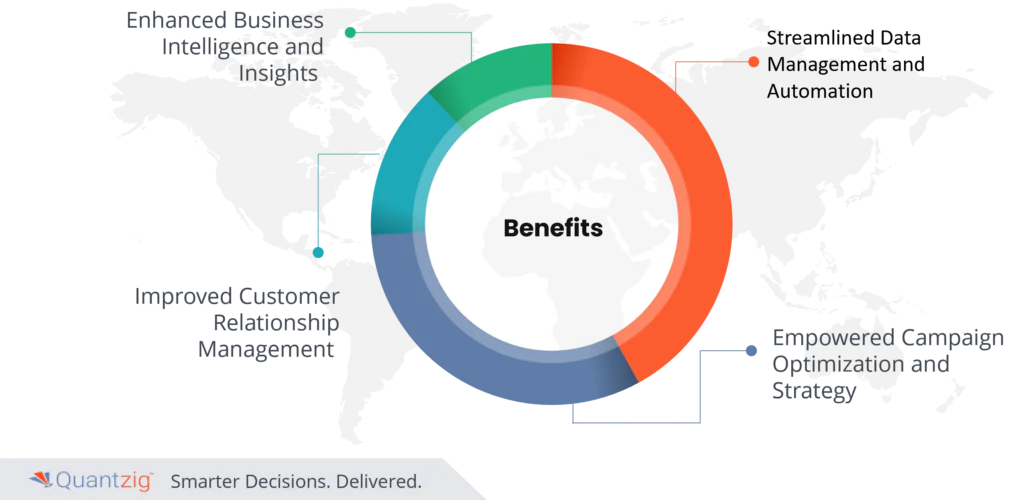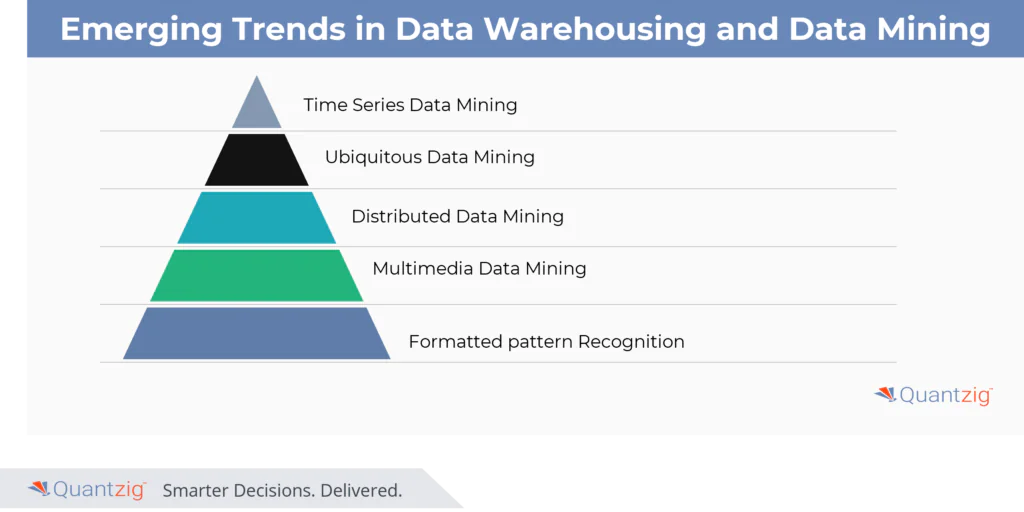Table of Contents
Introduction to Data Warehousing and Data Mining
To succeed in a competitive business landscape, companies must mine and manipulate data for actionable insights effectively and quickly. Leveraging data warehousing and data mining techniques provides a competitive edge, enhancing customer experience and driving growth.
Business leaders face key questions:
- Should I invest in data warehousing and mining software?
- Is it better to hire analysts or consult an external provider?
- How can these techniques solve business challenges?
Responses depend on industry and project needs. Leaders should understand the characteristics of data warehousing and data mining tools to select the right problems to tackle and the best solutions for their requirements.
Book a demo to experience the meaningful insights we derive from data through our analytical tools and platform capabilities. Schedule a demo today!
Request a Free Demo nowWhat is Marketing Data Warehousing?
Marketing data warehousing involves collecting, storing, and analyzing extensive marketing data to inform business decisions and strategies. By consolidating information from sources like customer interactions, sales, social media, and website analytics, marketers can easily access data to track campaign performance, measure ROI, and understand customer behavior.
This approach centralizes marketing data for targeted campaigns but poses challenges, such as the risk of storing irrelevant information and potential data loss during cleansing. Despite these issues, leveraging data mining tools provides actionable insights for effective risk management and targeted marketing. Ultimately, marketing data warehousing enables organizations to uncover trends and make efficient, data-driven decisions.
Applications of Data Warehousing and Data Mining
Organizations rely on data warehousing and data mining to extract valuable insights from vast volumes of structured data. These technologies play a crucial role in enhancing management functions and facilitating informed decision-making processes. By integrating data from diverse sources and consolidating it into a central repository, data warehousing provides a subject-oriented approach to organizing corporate data. Meanwhile, data mining techniques such as association rules and boxplot analysis help uncover hidden patterns and relationships within the data, offering useful information for strategic planning and business optimization.
| Application | Description |
|---|---|
| 1. Database Marketing and Targeting | Leverages diverse data sources to create targeted campaigns using machine learning. This approach automates the discovery of trends and preferences, enhancing marketing effectiveness and research-driven outcomes. |
| 2. Credit Risk Management and Credit Scoring | Financial institutions use data warehousing and mining to assess credit risk by analyzing historical financial data. This enables lenders to identify risks, make informed decisions, and develop predictive credit scoring models. |
| 3. Fraud Detection and Prevention | Analyzes transactions to identify suspicious patterns across sectors like finance and retail. Data mining enhances fraud detection capabilities, leading to improved security measures and reduced financial losses. |
| 4. Healthcare Bioinformatics | Utilizes data analysis from healthcare and insurance sectors to improve patient care and predict healthcare costs. This drives innovation, enhances diagnostic accuracy, and optimizes resource allocation in healthcare delivery. |
| 5. Spam Filtering | Employs data mining to analyze email patterns, identifying spam characteristics. Classification and neural networks help filters adapt to new spamming techniques, enhancing email security and productivity. |
| 6. Sentiment Analysis | Analyzes textual data from social media and reviews using clustering and classification algorithms. This provides insights into customer opinions, enabling businesses to enhance satisfaction and make informed decisions. |
| 7. Qualitative Data Warehousing and Data Mining | Analyzes non-numeric data cost-effectively using advanced techniques like K-nearest neighbors and Support Vector Machines. This approach helps predict behavior and drive innovation through valuable insights from diverse data sources. |
Data warehousing and mining streamline processes and improve decision-making by ensuring data accuracy and quality. As technology evolves, these tools will be essential for organizations aiming to thrive in a data-centric landscape.
Benefits of Implementing a Marketing Data Warehouse
By harnessing the capabilities of advanced ETL tools and automation, businesses can streamline data processes and unlock valuable insights. This facilitates informed strategy formulation, targeted campaign execution, and optimized customer relationship management systems. In this context, exploring the benefits of implementing a data warehouse reveals its pivotal role in driving organizational success and fostering innovation.
| Benefit | Description |
|---|---|
| 1. Enhanced Business Intelligence and Insights | Data warehousing solutions provide a centralized storage solution through enterprise data warehousing, integrating diverse data sources. This data warehousing architecture enables businesses to gain deeper insights into operations and customer behavior, facilitating comprehensive reporting and informed decision-making using data warehousing tools and advanced visualization techniques. |
| 2. Streamlined Data Management and Automation | A robust data warehouse simplifies ETL processes and data warehouse management tasks. Cloud data warehousing and cloud-based data warehousing platforms offer automated ETL processes, ensuring data consistency and accuracy. This streamlines data warehousing for businesses, allowing quicker access to relevant information for decision-making and enhancing campaign optimization efforts. |
| 3. Improved Customer Relationship Management | Centralizing customer data within business data warehousing systems enhances CRM capabilities. Organizations can leverage data warehousing for analytics to identify patterns in customer behavior, facilitating personalized marketing campaigns and fostering stronger relationships. This drives engagement and loyalty through tailored strategies based on insights derived from data mining services. |
| 4. Empowered Campaign Optimization and Strategy | A solid foundation in data warehouse design enables effective marketing campaign optimization. By leveraging modern data warehousing and advanced analytics tools, businesses can analyze campaign performance, uncover hidden patterns, and implement data warehouse optimization strategies, maximizing ROI while adapting to market changes in real-time. |
Implementing a data warehouse is essential for organizations looking to harness the full potential of their data assets. It enhances business intelligence, streamlines data management, and improves customer relationship management. By understanding how data warehousing works, businesses can optimize their data strategies while considering the benefits of data warehousing and best practices for data warehousing.
At Quantzig, we provide data warehousing consulting, data mining solutions, and insights into data warehousing vs. data lakes to help you navigate data warehousing in cloud computing effectively. Our expertise in predictive data mining and advanced data mining techniques ensures your organization is positioned for sustained growth and success in today’s data-driven landscape.
Get started with your complimentary trial today and delve into our platform without any obligations. Explore our wide range of customized, consumption driven analytical solutions services built across the analytical maturity levels.
Start Your Free Trial nowEmerging Trends in Data Warehousing and Data Mining
Data warehousing and data mining techniques hold a prominent place in every business agenda and are used widely to make crucial business decisions. It’s growing popularity can be attributed to its ability to drive positive business outcomes. A few years down the line, we expect data warehousing and data mining applications to become as ubiquitous as some of the prevalent components and technologies used today. Some of the emerging data warehousing and data mining trends are listed below.
1. Time Series Data Mining
Time series-based data mining techniques help businesses to mine data to analyze periodic trends. This practice is also helpful in analyzing random events that occur outside the regular series of events. As such, it is used by players across industries, especially the retail sector, where retailers used time-series data mining methodologies to understand customer needs and analyze their buying behavior.
2. Ubiquitous Data Mining
This method involves the mining of data from mobile devices to get business information about individuals. This data mining method offers many opportunities for players across industries, especially in studying human-computer interactions.
3. Distributed Data Mining
This type of data mining is gaining popularity as it involves analyzing the business information stored in different company locations or at different organizations. Highly sophisticated algorithms are used to extract data from different locations and provide detailed insights to aid decision making.
4. Multimedia Data Mining
With the growing popularity of different kinds of multimedia sources such as text, audio, video, and images, businesses and marketers are now focusing on leveraging data mining tools to extract valuable insights from disparate sources of data. Multimedia data mining is a data mining technique that extracts data from different sources and converts it into a numerical representation for easy analysis. Apart from data clustering and classification, multimedia data mining also helps perform similarity checks to identify associations between data sets.
5. Formatted pattern Recognition
One emerging trend in data warehousing and data mining is the increasing focus on formatted pattern recognition. With the exponential growth of data, organizations are leveraging advanced algorithms and machine learning techniques to identify structured patterns within their historical data. These patterns, when recognized and analyzed through query tools and online analytical processing, provide valuable insights for decision-making and strategic planning. By incorporating formatted pattern recognition into their data management practices, businesses can enhance transaction processing efficiency and drive innovation in management functions.
In data management, traditional databases play a vital role in storing and organizing vast volumes of historical data. These databases utilize query tools for efficient data retrieval and analysis, supporting various management functions. Additionally, online analytical processing enables real-time insights generation from structured data. As emerging trends in data management unfold, there’s a growing emphasis on formatted pattern recognition and advanced data cleaning techniques to enhance the accuracy and reliability of information. This evolution paves the way for innovative approaches in transaction processing and data warehousing, driving the exploration of new opportunities in data mining applications.
Experience the advantages firsthand by testing a customized complimentary pilot designed to address your specific requirements. Pilot studies are non-committal in nature.
Request a Free PilotConclusion
In conclusion, the intersection of data warehousing and data mining presents a dynamic landscape ripe with opportunities and emerging trends for businesses. By leveraging robust data warehouses as centralized repositories, organizations can streamline data storage and facilitate seamless integration of diverse data sources. This empowers cross-functional teams and marketers with access to a single source of truth, enhancing query and analysis capabilities and driving informed decision-making across departments. Through advanced visualization tools, Artificial Intelligence, Machine Learning, and intuitive dashboards, marketers gain deeper insights into customer segmentation and campaign performance, optimizing marketing strategies for maximum ROI. With a focus on scalability, security, and integration, data warehousing and data mining continue to guide companies toward a data-driven future, where actionable insights pave the way for sustained success.




